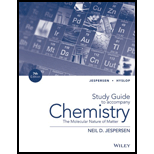
Concept explainers
Interpretation:
The condensed structures and IUPAC (International Union of Pure and Applied Chemistry) names for all the saturated alcohols with three or fewer carbon atoms per molecule are to be represented.
Concept Information:
Alcohol is an organic compound in which an OH group is attached to the carbon atom. The naming of the alcohol group is done by replacing –e with an –ol.
The IUPAC names are developed for each compound for their systematic categorization.
General rules for
•Recognize the functional group in the compound to determine the suffix of the name like, -ane for
•Find the longest continuous carbon chain that contains the functional group and count the number of carbon atoms in this chain to determine the prefix of the compound name like, Meth- for single carbon, eth- for 2 carbon chain, prop- for 3 carbon chain, etc.
•Number the carbons in the longest carbon chain by stating with the carbon at the end closest to the functional group.
•Look for any branched groups, name them and assign the number of the carbon atom to which the group is attached like 2,4-.
Saturated alcohols are defined as the alcohol groups in which the carbon atoms have single bonds between them. They are polar in nature and are more water soluble than any other hydrocarbon.
Want to see the full answer?
Check out a sample textbook solution
Chapter 22 Solutions
Study Guide To Accompany Chemistry: The Molecular Nature Of Matter, 7e
- What is the IUPAC name for the compound shown? How do I differentiate between the ethyl groups and the methyl groups using only the skeletal structure?arrow_forwardWrite the IUPAC name of the following saturated hydrocarbonsarrow_forwardIndicate the equivalent condensed formula and assign the IUPAC namearrow_forward
- write the expanded structural formula and organic family of the following compoundsarrow_forwardDraw the condensed structure for: propane cyclobutanearrow_forwardThe following names are incorrect. Draw the structure of the compound and provide the correct IUPAC name. Molecule #1: triisobutylmethane Molecule #2: trimethylmethanearrow_forward
- Chemistry: Matter and ChangeChemistryISBN:9780078746376Author:Dinah Zike, Laurel Dingrando, Nicholas Hainen, Cheryl WistromPublisher:Glencoe/McGraw-Hill School Pub Co
 Introductory Chemistry: An Active Learning Approa...ChemistryISBN:9781305079250Author:Mark S. Cracolice, Ed PetersPublisher:Cengage Learning
Introductory Chemistry: An Active Learning Approa...ChemistryISBN:9781305079250Author:Mark S. Cracolice, Ed PetersPublisher:Cengage Learning  Chemistry for Today: General, Organic, and Bioche...ChemistryISBN:9781305960060Author:Spencer L. Seager, Michael R. Slabaugh, Maren S. HansenPublisher:Cengage Learning
Chemistry for Today: General, Organic, and Bioche...ChemistryISBN:9781305960060Author:Spencer L. Seager, Michael R. Slabaugh, Maren S. HansenPublisher:Cengage Learning



